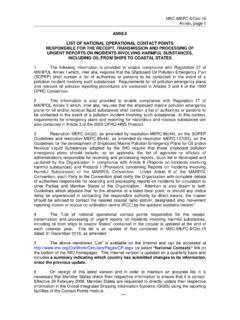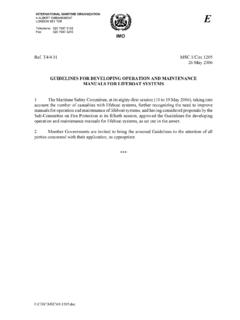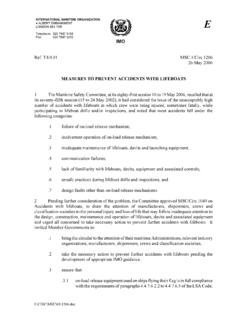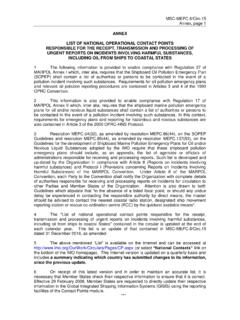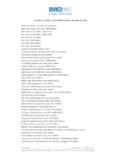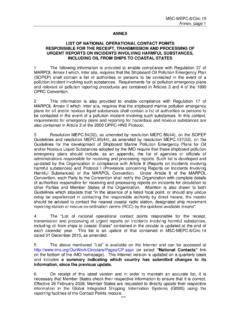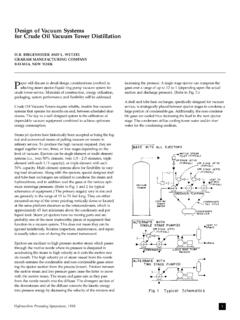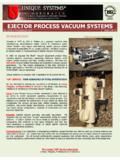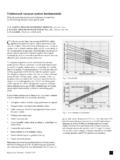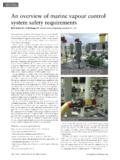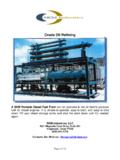Transcription of TECHNICAL INFORMATION ON SYSTEMS AND OPERATION TO …
1 I:\CIRC\MEPC\01\ INTERNATIONAL MARITIME ORGANIZATION 4 ALBERT EMBANKMENT LONDON SE1 7SR Telephone: 020 7735 7611 Fax: 020 7587 3210 IMO E Ref. T5 27 July 2009 TECHNICAL INFORMATION ON SYSTEMS AND OPERATION TO ASSIST DEVELOPMENT OF VOC MANAGEMENT PLANS 1 The Marine Environment Protection Committee, at its fifty-ninth session (13 to 17 July 2009), approved the Guidelines for the Development of a Volatile Organic Compound (VOC) Management Plan for tankers carrying crude oil (resolution (59)). 2 In conjunction with consideration of the guidelines, MEPC 59 agreed that additional TECHNICAL INFORMATION on vapour pressure control SYSTEMS and their OPERATION would assist the industry in development of VOC management plans. Therefore, MEPC 59 agreed to the TECHNICAL INFORMATION on SYSTEMS and OPERATION to assist development of VOC management plans for tankers carrying crude oil, as set out in the annex to this document.
2 3 The TECHNICAL INFORMATION addresses the general equipment and SYSTEMS involved, their OPERATION and conditions on board a crude oil tanker with respect to the formation and emission of Volatile Organic Compounds (VOC) as well as the ability to control VOC formation andemissions. 4 Member Governments are invited to bring this circular to the attention of their Administrations, relevant shipping organizations, recognized organizations, shipping companies and other stakeholders concerned and encourage them to take it into account when applying the Guidelines for the development of a VOC management plan for crude oil tankers. ** I:\CIRC\MEPC\01\ ANNEX TECHNICAL INFORMATION ON VAPOUR PRESSURE CONTROL SYSTEMS AND THEIR OPERATION TO ASSIST DEVELOPMENT OF VOC MANAGEMENT PLANS FOR TANKERS CARRYING CRUDE OIL Introduction This TECHNICAL INFORMATION is compiled pursuant to the requirements in MARPOL Annex VI Regulation , and describes the general equipment, operations and conditions onboard a crude oil tanker with respect to the emission and ability to control Volatile Organic Compound (VOC)emissions.
3 The Guidelines for the development of a VOC management plan state: 1 Objectives .1 The purpose of the VOC management plan is to ensure that the OPERATION of a tanker, to which regulation 15 of MARPOL Annex VI applies, prevents or minimizes VOC emissions to the extent possible..2 Emissions of VOCs can be prevented or minimized by: .1 optimizing operational procedures to minimize the release of VOC emissions; and/or .2 using devices, equipment, or design changes to prevent or minimize VOC emissions..3 To comply with this plan, the loading and carriage of cargoes which generate VOC emissions should be evaluated and procedures written to ensure that the operations of a ship follow best management practices for preventing or minimizing VOC emissions to the extent possible. If devices, equipment, or design changes are implemented to prevent or minimize VOC emissions, they shall also be incorporated and described in the VOC management plan as appropriate.
4 4 While maintaining the safety of the ship, the VOC management plan should encourage and, as appropriate, set forth the following best management practices: .1 the loading procedures should take into account potential gas releases due to low pressure and, where possible, the routing of oil from crude oil manifolds into the tanks should be done so as to avoid or minimize excessive throttling and high flow velocity in pipes; .2 the ship should define a target operating pressure for the cargo tanks. This pressure should be as high as safely possible and the ship should aim to maintain tanks at this level during the loading and carriage of relevant cargo; ANNEX Page 2 I:\CIRC\MEPC\01\ .3 when venting to reduce tank pressure is required, the decrease in the pressure in the tanks should be as small as possible to maintain the tank pressure as high as possible.
5 4 the amount of inert gas added should be minimized. Increasing tank pressure by adding inert gas does not prevent VOC release but it may increase venting and therefore increased VOC emissions; and .5 when crude oil washing is considered, its effect on VOC emissions should be taken into account. VOC emissions can be reduced by shortening the duration of the washing or by using a closed cycle crude oil washing programme. 2 Additional considerations .1 A person in charge of carrying out the plan .1 A person shall be designated in the VOC management plan to be responsible for implementing the plan and that person may assign appropriate personnel to carry out the relevant tasks; .2 Procedures for preventing or minimizing VOC emissions .1 Ship-specific procedures should be written or modified to address relevant VOC emissions, such as the following operations .
6 1 Loading; .2 Carriage of relevant cargo; and .3 Crude oil washing; .2 If the ship is equipped with VOC reduction devices or equipment, the use of these devices or equipment should be incorporated into the above procedures as appropriate..3 Training .1 The plan should describe the training programmes to facilitate best management practices for the ship to prevent or minimize VOC emissions. ANNEX Page 3 I:\CIRC\MEPC\01\ Section 1 The hull and its pressure limitations Allowable cargo tank ullage pressure The cargo tank structure is designed to withstand a range of design loads and parts of the tank structure will also contribute to the global longitudinal strength of the ship. The classification societies specified load conditions and loads are applied in verification of the structural design. One such load is the combined pressure from the liquid cargo and the tank ullage pressure.
7 The tank ullage pressure is to be minimum 25 kN/m2 or the opening pressure of the pressure relief device (P/V valve), whichever is greater. Accordingly, the maximum allowable ullage pressure in a standard tanker is typically interpreted as 25 kN/m2 ( approximately 2,550 mmWG). It should however be noted that global strength considerations and the impact of other design loads may imply that actual allowable pressure could be higher. In terms of under pressure, SOLAS regulation II-2 indicates an allowable under pressure of -700 mmWG. From a structural point of view, the maximum allowable tank under pressure is presumably lower. Exceeding the maximum allowable pressures could lead to structural failures. If such a structural failure results in opening of the tank structure to atmosphere, uncontrolled VOC emissions will occur together with the possibility of oil pollution to the seas.
8 Further, it could result in loss of inert gas protection with subsequent hazards related to fire and explosion. Typical cargo tank venting SYSTEMS The design of cargo tank venting and inert gas SYSTEMS is governed by SOLAS regulation II-2 and 5. Most crude oil tankers have a common cargo tank venting and inert gas main pipeline which is also used for vapour emission control (ref. section 4). Branches to each cargo tank are provided with isolation valves and blanking arrangements. The isolation valves and blanks are typically only used in connection with tank entry. SOLAS chapter II-2 requires that the isolation valves are to be provided with locking arrangements to prevent inadvertent closing/opening of said tanks. The cargo tank venting/inert gas main is connected to a mast riser. The mast riser has a minimum height of 6 metres with an IMO approved flame arrestor at its outlet.
9 An isolation valve is provided between the cargo tank venting/inert gas main and the mast riser. Some designs have a small capacity pressure/vacuum valve fitted in a bypass across the isolation valve. This latter enables thermal breathing from cargo tanks when the isolation valve is closed. A liquid-filled P/V breaker is typically connected to the cargo tank venting/inert gas main. The P/V breaker has a capacity to accommodate the gas flow from cargo tanks during loading (125% of the loading rate and discharge rate). The cargo tank venting/inert gas main is typically used during loading and discharging operations . During loading the mast riser valve is open (unless vapour emission control is performed) and VOC is expelled to air. During discharge the same valve is closed and inert gas used to replace the tank atmosphere. The cargo tank venting/inert gas main is also used during voyage but the mast riser valve will be operated only in the event of increasing ullage pressure.
10 ANNEX Page 4 I:\CIRC\MEPC\01\ In addition to the common cargo tank venting/inert gas main, each cargo tank is required to have a pressure/vacuum relief device for thermal breathing in the event the cargo tank is isolated from the common cargo tank venting/inert gas main. Although classification societies accept that these devices have the capacity to accommodate gas volumes resulting from variations in cargo temperature only ( thermal breathing), latest industry practices have led to the installation of devices with the capacity to accommodate the full gas flow from loading of cargo tanks. Typical settings of pressure/vacuum relief devices Although the design pressure of cargo tanks is typically +2,500 mmWG and -700 mmWG, the typical setting of pressure/vacuum valves on crude tankers is +1,400 mmWG and -350 mmWG.
